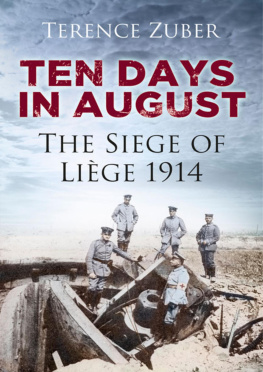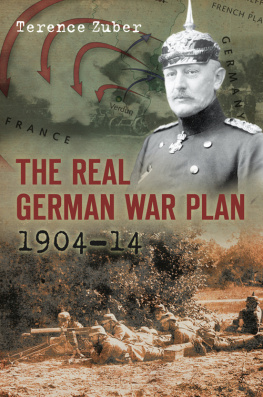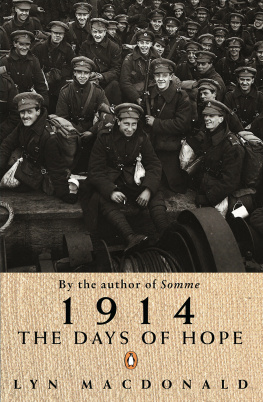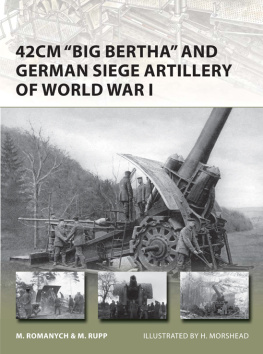Terence Zuber - Ten Days in August- the Siege of Liège 1914
Here you can read online Terence Zuber - Ten Days in August- the Siege of Liège 1914 full text of the book (entire story) in english for free. Download pdf and epub, get meaning, cover and reviews about this ebook. year: 2014, publisher: The History Press, genre: Non-fiction. Description of the work, (preface) as well as reviews are available. Best literature library LitArk.com created for fans of good reading and offers a wide selection of genres:
Romance novel
Science fiction
Adventure
Detective
Science
History
Home and family
Prose
Art
Politics
Computer
Non-fiction
Religion
Business
Children
Humor
Choose a favorite category and find really read worthwhile books. Enjoy immersion in the world of imagination, feel the emotions of the characters or learn something new for yourself, make an fascinating discovery.
- Book:Ten Days in August- the Siege of Liège 1914
- Author:
- Publisher:The History Press
- Genre:
- Year:2014
- Rating:5 / 5
- Favourites:Add to favourites
- Your mark:
- 100
- 1
- 2
- 3
- 4
- 5
Ten Days in August- the Siege of Liège 1914: summary, description and annotation
We offer to read an annotation, description, summary or preface (depends on what the author of the book "Ten Days in August- the Siege of Liège 1914" wrote himself). If you haven't found the necessary information about the book — write in the comments, we will try to find it.
Ten Days in August- the Siege of Liège 1914 — read online for free the complete book (whole text) full work
Below is the text of the book, divided by pages. System saving the place of the last page read, allows you to conveniently read the book "Ten Days in August- the Siege of Liège 1914" online for free, without having to search again every time where you left off. Put a bookmark, and you can go to the page where you finished reading at any time.
Font size:
Interval:
Bookmark:

Contents
This book would probably not have been possible without the support of Daniel Neicken, who lives near Lige. On hearing of my project, he was kind enough to approach me and offer to assist in obtaining source materials. He was of inestimable help and I cannot thank him enough. Dan bears no responsibility for the conclusions I have drawn.
I conducted much of the research while at the University of Wrzburg, thanks to the hardworking and efficient interlibrary loan section.
I received invaluable support from West Virginia Northern Community College, especially the librarian, Janet Corbett and the dean, Larry Tackett.
Once again, Heather Wetzell drew the maps.
All the records of the German units that fought at Lige were located in the military archive at Potsdam, which was destroyed by a British firebomb raid on the night of 14 April 1945, two weeks before the end of the war. The principal German sources will therefore be the German infantry and artillery regimental histories as well as Das Ehrenbuch der Deutschen Schweren Artillerie (The Book of Honour of the German Heavy Artillery).
There are two German monographs concerning the attack on Lige. Lttich-Namur (Lige-Namur), book one of the series Der Grosse Krieg in Einzeldarstellungen (The Great War in Individual Campaigns). In fact, the story is pure invention, the Guard Foot Artillery Regiment was never engaged at Lige.
Ernst Kabisch began the war commanding an infantry regiment in Lorraine, but was wounded at the beginning of September. He was then chief of staff at increasing levels, and commanded a brigade and a division. His Lttich (Lige) is more an apologia for the attack, along with his recommendations which would have made the attack more effective, than it is military history. It is about 180 pages long but surprisingly quite general: his discussion of the attack and the siege contain no tactical details; it also contains numerous errors. However, Kabisch does make some interesting judgements.
The German official history, Der Weltkrieg , contains a short (nine-page) and accurate summary of the infantry attack on the night of 56 August.
The Belgian Army historical records concerning 191418 were in two railcars which were destroyed in a fire at the rail station in Dunkirk on 25 May 1940. All that survived concerning Lige is a short and completely inadequate summary. De Schrvers book is the most complete Belgian source, with 258 very dense pages, but he did not include any tactical maps.
Laurent Lombard wrote a series of five monographs on the battle at Lige in the 1930s. Lombard was a high school teacher who lived near Lige and was involved in the Belgian resistance in both world wars, escaping execution in the Great War only because he was under-age. Lombards strength is in his description of Belgian tactical operations and tactical maps, which are far better than those of the German regimental histories. Lombard looked at all the published work in both French and German, but did not use the Belgian archives. His use of the German sources is selective and tendentious. His prose is far too wordy, emotional and florid. His description of the battle from the Belgian point of view is invaluable, but has to be treated very carefully. His judgement is unreliable, influenced by intense Belgian patriotism and his ignorance of tactics.
An important and brutally honest source concerning the fortifications at Lige is the highly-detailed 800-page Belgian official history, Dfense de la Position Fortifie de Namur en Aot 1914. A French engineer officer, his book contains a technical description of the fortresses, which, however, missed some very important factors concerning armament and tactical defensive capabilities. Its account of the battle is largely a translation of the German Lttich-Namur and Ludendorffs memoirs, but does include some valuable snippets concerning Belgian operations.
One of the most valuable sources is the report of the Belgian commander, General Leman. Leman pulled no punches, and his critique of the state of the pre-war Belgian Army and the fortress of Lige is scathing.
Emile Joseph Galets Albert, King of the Belgians in the Great War (translated by Major General Sir Ernst Swinton)
One of the few accounts of the battle in English is C. Donnell, The Forts of the Meuse in World War I .
German time was an hour ahead of Belgian time: 0900 German time was 0800 Belgian time. Where confusion might arise, German time is listed as (G), Belgian as (B). Times stated are, however, generally approximate.
Notes
F.N. Kaiser (ed.), Das Ehrenbuch der Deutschen Schweren Artillerie (Berlin: Kolk, 1931).
Marschall von Bieberstein, Lttich-Namur (Oldenburg: Stalling, 1918). Bieberstein was a Rittmeister (cavalry captain) and at Lige an assistant adjutant in 14 ID. Stalling was the publisher of the influential Deutsches Offiziersblatt (German Officers Journal).
Bieberstein, Lttich-NAMUR, 52.
E. Kabisch, Lttich. Deutschlands Schicksalschritt in den Weltkrieg (Berlin: Schlegel, 1934).
Reichsarchiv, Der Weltkrieg I (Berlin: Mittler, 1925) 108117.
Weltkrieg I, 119.
G. Leman, Le Rapport du gnral Leman sur la defense de Lige en aot 1914. (Brussels: Palais des Acadmes, 1960). Notes 16 and 25 by the editor of General Lemans report, Major Hautecler.
Colonel De Schrver, La Bataille de Lige (Lige: H. Vaillant-Carmanne, 1922).
Ministre de la Dfense Nationale Etat-Major Gnral de lArme. Section de lHistorique. Dfense de la Position Fortifie de Namur en Aot 1914 (Brussels: Institut Cartographique Militaire, 1930).
R. Normand, Dfense de Lige, Namur, Anvers en 1914 (Paris: Fournier, 1923).
Leman, Le Rapport du gnral Leman sur la defense de Lige en aot 1914 (Brussels: Palais des Acadmes, 1960).
E.J. Galet. Albert, King of the Belgians in the Great War (Boston: Houghton Mifflin, 1931).
Selliers de Moranville, Du Haut de la Tour du Babel (Paris: Berger-Levrault, 1925).
B. Duvivier/B. Herbiet, Du Rle de lArme de Campagne et des Fortresses belges en 1914 (Bruxelles: lInstitut Cartographique Militaire, 1928).
Christian Faque, Henri-Alexis Brialmont. Les Forts de la Meuse 18871891 (Les Amis de la Citadelle de Namur, 1987). L. Ruther, Fort de Loncin (Ans: Front de Sauvegarde du Fort de Loncin, 2009). Ruther is the administrator of the Front to Safeguard the Fort de Loncin. Comite de Sauvegarde du Patrimonie Historique du Fort de Hollogne, Le Fort de Hollogne dans la Position Fortifie de Lige en 1914 (No publisher, no date).
C. Donnell, The Forts of the Meuse in World War I (Oxford: Osprey, 2007).
On page 41, Donnell captions a picture with Civilians flee as German troops cross the border into Belgium. The troops and civilians are, however, moving in the opposite direction, so if the civilians are fleeing theyre fleeing into Germany. The occupants of the nearest automobile appear to be in a pleasant discussion with some German Jger.
Siege Warfare
Shortly after the Napoleonic wars the increasing range and effectiveness of siege artillery had forced engineers to abandon the bastioned trace, exemplified by Vaubaun, and construct detached forts some distance from the point to be defended, frequently but not always a city. The detached forts would be linked by field fortifications trenches dug at the commencement of hostilities, if not somewhat before. This was called arming a fortress. The detached forts would serve as strongpoints for the defence. The attacker would concentrate his main point of effort against what he considered a weak point. The attacker would have to engage three forts: one in the centre (the main point of attack) and the forts on each side that would provide supporting, and ideally flanking, fire for the centre fort. The defender would move additional forces, particularly artillery, to reinforce the threatened area. Fortresses like Metz had massive parks of mobile and semi-mobile 15cm heavy howitzers and long-range 10cm and 13cm cannon, backed up by full munitions bunkers, with which to conduct a protracted artillery duel at the decisive point.
Next pageFont size:
Interval:
Bookmark:
Similar books «Ten Days in August- the Siege of Liège 1914»
Look at similar books to Ten Days in August- the Siege of Liège 1914. We have selected literature similar in name and meaning in the hope of providing readers with more options to find new, interesting, not yet read works.
Discussion, reviews of the book Ten Days in August- the Siege of Liège 1914 and just readers' own opinions. Leave your comments, write what you think about the work, its meaning or the main characters. Specify what exactly you liked and what you didn't like, and why you think so.













